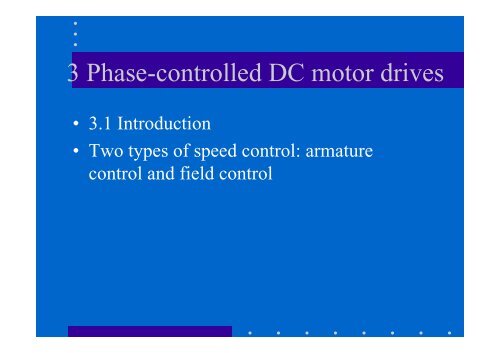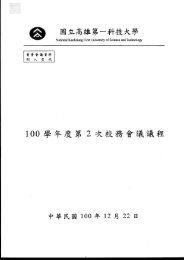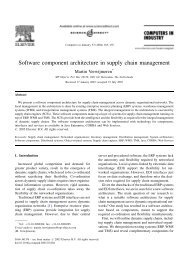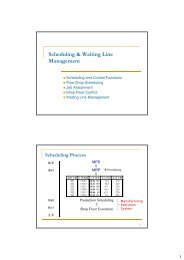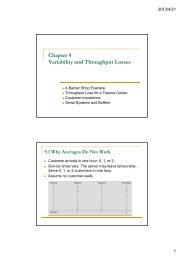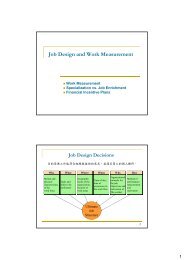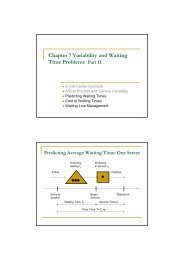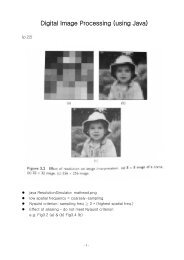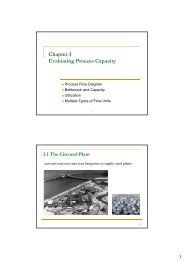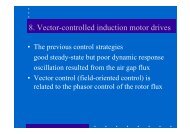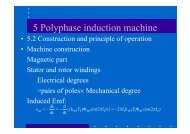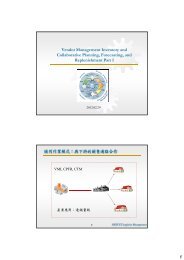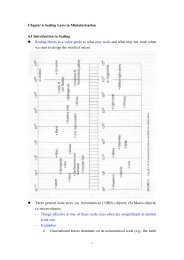3 Phase-controlled DC motor drives
3 Phase-controlled DC motor drives
3 Phase-controlled DC motor drives
- No tags were found...
Create successful ePaper yourself
Turn your PDF publications into a flip-book with our unique Google optimized e-Paper software.
3 <strong>Phase</strong>-<strong>controlled</strong> <strong>DC</strong> <strong>motor</strong> <strong>drives</strong>• 3.1 Introduction• Two types of speed control: armaturecontrol and field control
3.2 Principles of <strong>DC</strong> <strong>motor</strong>s speed Control• The induced voltage is dependent on thefield flux and speede = Kφ f ω m• The flux is proportional to the field currentφ f ∝ i f• The speed is expressed asωm∝eφfe∝if(v − i∝ifaRa)• The rotor speed is dependent on the appliedvoltage and field current.
• In field control, the applied armaturevoltage v is maintained constant.• Then the speed is represented as1ωm ∝ if• In armature control, the field current ismaintained constant. Then the speed isderived asωm∝ ( v − iaRa)
• Hence, varying the applied voltage changesspeed. Reversing the applied voltage changesthe direction of rotation of the <strong>motor</strong>.• The advantage: the field time constant is atleast 10 to 100 times greater than the armaturetime constant.• Armature control is idea for speeds lowerthan rated speed; field control is suitableabove for speeds greater than the rated speed.
• Fig. 3.1
• By combining armature and field control, awide range of speed control is possible.• The relationship between armature currentand torqueT e = Kφ f i a• The rated torqueT er = Kφ fr i ar• The normalized versionTenT=Teer=KφKφffriiaarφ= (φffri)(iaar)=φfnian,p.u.(perunit)
• Similarly, the air gap power isP an = e n i an , p.u.where e n is the normalized induced emf.•As i an is set to 1 p.u., the normalized air gappower becomesP an = e n , p.u.• The steady-state power output is kept fromexceeding its rated design value, which is 1p.u.
• The air gap power constrains the induced emfand flux field asP an = 1 p.u. = e n i an = φ fn ω mn i an• If i an is equal to 1 p.u., thenφ fn ω mn = 1 φ fn = 1/ω mn• Hence, the normalized induced emf ise n = 1• In the field weaken region, the power outputand induced emf are maintained at their ratedvalues by programming the field flux to beinversely proportional to the rotor speed.
3.2.5 Four-quadrant operation• During a steady speed of ω m , stoping a machineneed to slow down at zero speed first.• Four-quadrant dc <strong>motor</strong> drive characteristicfunction Quadrant Speed Torque PowerFM I + + +FR IV + - -RM III - - +RR II - + -
• Fig. 3.4 shows four-quadrant torque-speedcharacteristics
• Fig. 3.5 illustrates the speed and torquevariation.
• Converter requirements: The voltage andcurrent requires four quadrant operation.• The relationship between armature voltage andarmature currentOperation Speed Torque Voltage Current Power OutputFM + + + + +FR + - + - -RM - - - - +RR - + - + -
• Two basic methods by using static converterThe First method: using phase-controllerconverter to converter the ac source voltagedirectly into a variable dc voltage.The second method: Ac source voltage → fixeddc voltage → variable dc voltage.• Thyristor devices:SCR, Transistors, GTOs, MOSFETs, ect.
3.3 <strong>Phase</strong>-<strong>controlled</strong> converter• Fig 3.6 is a single-phase <strong>controlled</strong>-bridgeconverter (positive average value).
• The bridge conduction is delayed in latterbeyond positive zero crossing.• The delay angle is measured from the zerocrossing of voltage waveform and isgenerally termed α.• Thus, this voltage is quantified asVdc=1π∫α+παVmsin( ωst)d( ωst)=2Vπmcosα
• Fig. 3.7 is the <strong>controlled</strong>-converter operationwith negative average voltage (α > 90º).
• In the case that the load current is discontinuous, theaverage output isVdc1= ∫πα+γαVmsin( ωst)d( ωs[cos( α)− cos( α +where γ is the current conduction angle.• For certain value of γ, the output voltage fordiscontinuous conduction can be greater than thatfor continuous conduction.• For example, let α+γ=π, and α = 30VVdcdc(dis)(con)=t)=VπVmVm[cosα − cos( α + γ)]= 1.866ππ2Vm2Vm1.732 1.732Vcosα = =π π 2 π=mmγ)]
• The source inductance can be introduced toreduce the rate of rise of current in thethyristors.• If the source inductance is L ls , the voltagelost due to it is1 α+µVV V sin( t)d( t)mx = ∫ m ωsωs= [cosα − cos( α + µ )]παπwhere , the overlap conduction period isµ =cos−1[cosα −πωsLVlsmIdc] − α
• Fig. 3.10 is a three-phase thyristor-<strong>controlled</strong>converter.
• The thyristor requires small reactors in seriesto limit the rate of current rise, andsnubbers, which are resistors in series withcapacitors across the devices, to limit the rateof voltage rise.• The transfer characteristic of the three-phase<strong>controlled</strong> rectifier is derived asVdc=1∫π / 32π/ 3+απ / 3+αVmsin( ωst)d(ωscosα• The characteristic is nonlinear (as shown inFig. 3.13).t)=3Vπm
• A control technique to overcome thisnonlinear characteristic is that the controlinput to determine the delay angle ismodified to beα = cosv(V−1 c −1cm) = cos(vcn)where v c is the control input and V cm is themaximum of the absolute value.• Then the dc output voltage is3 3−13 ⎡ 3 Vm⎤V dc = Vmcosα = Vmcos(cos vcn) = [ Vm]vcn= ⎢ vc=π ππV⎥⎣πcn ⎦Krvc
• Fig. 3.14 is a schematic of a genericimplementation.• The maximum delay angle is usually set inthe range from 150 to 155 degree.
Control modeling• The gain of the linearized controller-basedconverter isKr =1.35VVcm,• The converter is a sampled-data system.The sampling interval gives an indication ofits time delay.• The delay may be treated as one half of thisinterval60 / 21T r = × (time period of one cycle) = ×360121fs
• The converter is then modeled withGr(s)=Kre−T sr• The above equation can also beapproximated by asGr(s)K=r(1 + sTr)• For the case that the transfer characteristicis nonlinear, the gain of the converter isobtained as a small-signal gain byKrδVδ=dc= {1.35Vcosα}= −1.35sinαδα δα
• Fig. 3.15 is current source converter.
• Fig. 3.16 current source operation.
• Fig. 3.17 is a half-<strong>controlled</strong> converter.
• Fig. 3.18 is the converter with freewheelingdiode.
• Fig. 3.20 shows the converter configurationfor a four-quadrant dc <strong>motor</strong> drive.
3.4 Steady-state analysis ...• Average values: The steady-state performanceis developed by assuming that the averagevalues only are considered.• The armature voltage equationv a = R a i a + e• Termed by average valuesV a = R a I a + KΦ f ω mav• Average electromagnetic torque isTav= KΦfIa= KΦfV{a− KΦRafωmav} =KΦf1.35V cos{α − KΦRafωmav}
• The normalized electromagnetic torqueTenTenT=T=averT=KΦ[1.35VavfrIarf{1.35V cosα − KΦKΦI R• Positive and <strong>motor</strong>ing torque is producedwhencosα >enKΦ=cosα − ΦRanΦfnω1.35Vmnnfnωmnfr]Φfnar,ap.u.fωmav}[1.35V cosα − KΦ=I Rarafωmav]Φfn
• Steady-state solution including harmonicsaccurately predict its electromagnetic torque• The speed of the machine and the fieldcurrent are assumed to be constant. ThendiRaaia+ La+ Kbωm=dtvawhere v a = V m sin(ω s t+π/3+α), 0
where ω s = 2πf s , β = tan -1 (ω s L a /R a ) = machineimpedance angle, T a =L a /R a = armature timeconstant, i ai = initial value of current at time t =0, Z a = R a +jω s L a = <strong>motor</strong> electrical impedance.• Critical triggering angle α c : when the armaturecurrent is barely continuous (iai = 0).αc= β + cos−1(E / V{c1m) 1⋅ ⋅(1− ecosβ−(π / 3tanβ))} −• When the current becomes discontinuous, thevoltage across the machine the is the inducedemf itself.π3+ θ1
• The steady state isRiaVaaia===+ L0,VmE,aωdidtstaxsin( ωωstx+ E =s< ωsVta,0 < ω< π / 3t + π / 3 + α),< ωst< π / 3st
• Fig 3.24
3.5 Two-Quadrant three-phase converter<strong>controlled</strong><strong>DC</strong> <strong>motor</strong> drive• Fig. 3.26 is speed-<strong>controlled</strong> two-quadrantdc <strong>motor</strong> drive
3.6 Transfer functions of the subsystems• Fig. 3.27 is <strong>DC</strong> <strong>motor</strong> and current-controlloop.
• Fig. 3.28 is step-by-step derivation of a dcmachine transfer function.
• Converter (after linearization)Gr=VVac(s)(s)K=r1+sTr• The current and speed controllers ofproportional-integral type areGGcsK(s) =K(s) =cs(1 + sTc)sTc(1 + sTs)sTs• The gain of current feedback is H c .• The transfer function of the speed feedbackfilter isKωGω(s) =1+sTω
3.7 Design of controllers• Fig 3.29 is the block diagram of the <strong>motor</strong> drive
• Fig 3.30 is current-control loop.
• Speed controller: Fig. 3.32 is the representationof the outer speed loop in the dc <strong>motor</strong> drive.
• The closed-loop transfer function of thespeed to its command isωω*rm(s)(s)=1Hω1+4T s[42 21+4T s + 8T s44+ 8T34s3]
3.8 Two-quadrant <strong>DC</strong> <strong>motor</strong>drive with field weakening• Fig. 3.38 is its schematic.
3.9 Four-quadrant Dc <strong>motor</strong> drive• Fig. 3.39 is its schematic.


